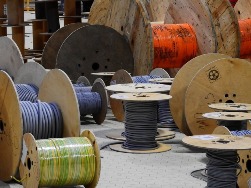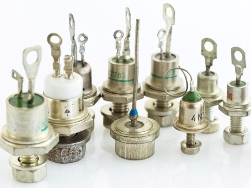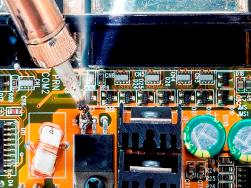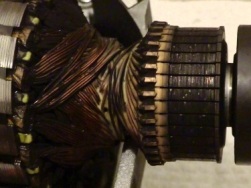 The process of manufacturing wires and cables is technologically implemented in several steps, the main of which are: drawing the workpiece, applying insulation, and the final stage is winding the finished product into bays. In fact, everything is somewhat more complicated, and at least two large workshops are allocated for cable production - the copper billet processing shop and the sheathing workshop.
The process of manufacturing wires and cables is technologically implemented in several steps, the main of which are: drawing the workpiece, applying insulation, and the final stage is winding the finished product into bays. In fact, everything is somewhat more complicated, and at least two large workshops are allocated for cable production - the copper billet processing shop and the sheathing workshop.
In the first workshop, the copper wire rod is drawn into wires and twisted, and already in the second workshop, the workpieces are passed through extrusion lines, where the cable acquires a complete insulated shape and is wound into coils. Let us, however, consider the technological process for the production of cables and wires in more detail and step by step on the example of the production of PVS brand wires. Raw material for copper veins serves as the so-called wire rod, which is a relatively thick copper billetdiameter of the order of 10 mm...
Power semiconductor devices: diodes and thyristors, their types and applications
 Power semiconductor devices - elements that are used in electric energy converters and in power plant circuits, are an integral component of both direct and alternating current circuits. They play the role of rectifiers or blockers that prevent switching overvoltages. Most often, these details are found in the designs of powerful turbine generators, galvanic plants, low-voltage welding devices, synchronous compensators, electric generators of cars and tractors.
Power semiconductor devices - elements that are used in electric energy converters and in power plant circuits, are an integral component of both direct and alternating current circuits. They play the role of rectifiers or blockers that prevent switching overvoltages. Most often, these details are found in the designs of powerful turbine generators, galvanic plants, low-voltage welding devices, synchronous compensators, electric generators of cars and tractors.
Power diodes are classified into low-frequency and frequency. The first can have a pin, tablet and avalanche versions. Silicon is used to produce such elements. Modifications are used in circuits with a frequency of up to 500 Hz. They can withstand vibration and repeated shock for a short time. Power diodes are used at frequencies from 2000 Hz and more ...
Electronic Circuit Troubleshooting Methods
 Most often, people are interested in electronics in order to be able to repair a device. Only a small part of lovers are engaged in self-development. Although theoretical knowledge provides a general understanding of how the components work, it’s much more important to know how to test them for repairs. We will tell you how to find a malfunction in an electronic circuit with your own hands, eyes and a simple tool.
Most often, people are interested in electronics in order to be able to repair a device. Only a small part of lovers are engaged in self-development. Although theoretical knowledge provides a general understanding of how the components work, it’s much more important to know how to test them for repairs. We will tell you how to find a malfunction in an electronic circuit with your own hands, eyes and a simple tool.
Before carrying out repairs it is important to determine what the problem is - this process is called diagnostics. So, we can distinguish two stages of testing electronic devices. It does not always happen that the device is completely “dead”, you need to check if the device does not turn on at all, or turns on and off immediately, or some specific buttons or functions do not work. For example, when repairing LCD monitors, there is such a problem as a backlight failure. At the same time, the monitor may or may not turn on completely then its indicator blinks ...
Household electric motors and their use
 Thanks to global electrification, our life has become more comfortable and cozy. The life of a modern person is impossible to imagine without electrical appliances. A lot of household appliances, which are entirely powered by electricity, are used today in every home. Even rural life is replete with various devices that make the economy more progressive and less burdensome for its owner.
Thanks to global electrification, our life has become more comfortable and cozy. The life of a modern person is impossible to imagine without electrical appliances. A lot of household appliances, which are entirely powered by electricity, are used today in every home. Even rural life is replete with various devices that make the economy more progressive and less burdensome for its owner.
In this article we will touch on the topic of household electric motors that faithfully serve in our vacuum cleaners, in washing machines, in coffee grinders, in food processors, in microwave ovens, and in many other household appliances, using which we don’t even think about how they are arranged, and how important the role of the electric motor is in them.Household electric motors are not many kilowatt industrial units, it is often the result of engineering to optimize common principles...
 Collector electric motors differ from other types of motors by the presence of a collector-brush assembly. The assembly provides an electrical connection of the rotor circuit with circuits located in the fixed part of the motor, and includes a collector (a set of contacts located directly on the rotor) and brushes (sliding contacts located outside the rotor and pressed against the collector).
Collector electric motors differ from other types of motors by the presence of a collector-brush assembly. The assembly provides an electrical connection of the rotor circuit with circuits located in the fixed part of the motor, and includes a collector (a set of contacts located directly on the rotor) and brushes (sliding contacts located outside the rotor and pressed against the collector).
During the operation of the commutator motor in a power tool, sparking brushes can sometimes be observed. In some cases, this symptom leads to an early breakdown of a power tool, and in some it does not bode well. One way or another, it is useful in each case to understand what the cause of sparking is, in order to take the right measures in time if necessary. In this article, we will consider the causes of sparking brushes, as well as measures to combat the problems that cause this phenomenon.Intermittent mechanical brush contact ...
RCD for lighting - to put or not?
 The question of whether to install an RCD on the lighting circuit has recently been relevant. Meanwhile, there are no strict regulations regarding the installation of RCDs on lighting lines. Let's see what the RCD can give in this case, and how things will be without it. After which each reader will be able to conclude for himself whether to put the RCD on the lighting or not.
The question of whether to install an RCD on the lighting circuit has recently been relevant. Meanwhile, there are no strict regulations regarding the installation of RCDs on lighting lines. Let's see what the RCD can give in this case, and how things will be without it. After which each reader will be able to conclude for himself whether to put the RCD on the lighting or not.
First, recall the principle of operation of the RCD. The differential current transformer inside the RCD allows you to detect the excess of the differential current. If such an excess occurs, the protected electrical circuit will open. RCD is included in the gap of the protected circuit - in the gap of the neutral and linear conductors. After the RCD is put into operation, the contact inside it is closed by a solenoid, held in this state, and the device freely passes a current through the supply circuit ...
Magnetic levitation - what is it and how is it possible
 The word "levitation" comes from the English "levitate" - to soar, to rise into the air. That is, levitation is the overcoming by the object of gravity when it soars and does not touch the support, without repelling from the air, without using jet propulsion. From the point of view of physics, levitation is a stable position of an object in a gravitational field, when gravity is compensated and there is a restoring force that provides the object with stability in space.
The word "levitation" comes from the English "levitate" - to soar, to rise into the air. That is, levitation is the overcoming by the object of gravity when it soars and does not touch the support, without repelling from the air, without using jet propulsion. From the point of view of physics, levitation is a stable position of an object in a gravitational field, when gravity is compensated and there is a restoring force that provides the object with stability in space.
In particular, magnetic levitation is the technology of lifting an object using a magnetic field, when magnetic action on an object is used to compensate for the acceleration of gravity or any other acceleration. It is about magnetic levitation that will be discussed in this article. Magnetic retention of an object in a state of stable equilibrium can be realized in several ways. Each of the methods has its own characteristics, and each can be presented ...
What is the effective, rms, effective voltage or current?
 Speaking of a value that varies according to a sinusoidal (harmonic) law, it is possible to determine its average value over half the period. Since the current in the network in our overwhelming majority of cases is sinusoidal, for this current its average value (for half the period) can also be easily found, it is enough to resort to the integration operation, setting the limits from 0 to T / 2.
Speaking of a value that varies according to a sinusoidal (harmonic) law, it is possible to determine its average value over half the period. Since the current in the network in our overwhelming majority of cases is sinusoidal, for this current its average value (for half the period) can also be easily found, it is enough to resort to the integration operation, setting the limits from 0 to T / 2.
Substituting Pi = 3.14, we find the average, over half the period, value of the sinusoidal current depending on its amplitude. Similarly, the average value of the sinusoidal EMF or sinusoidal voltage is found.However, the average value is not as widely used in practice as the effective value of a sinusoidal current or voltage. The effective value of a value sinusoidally varying in time is the root mean square value, in other words, its effective value ...
